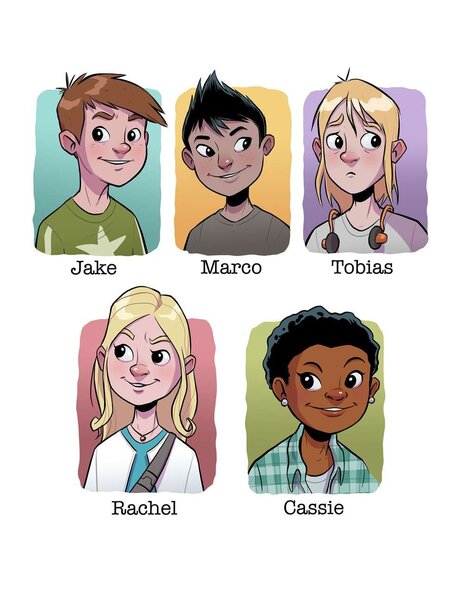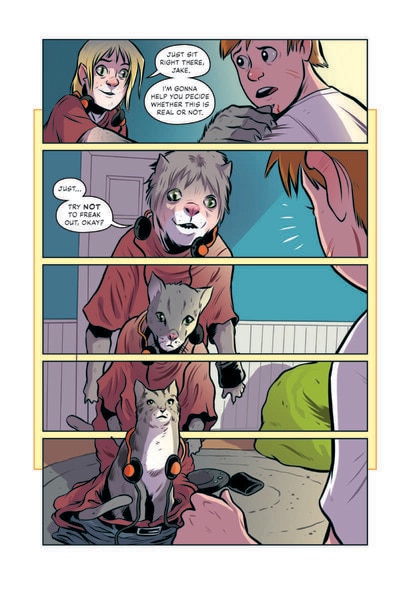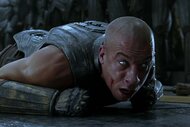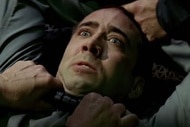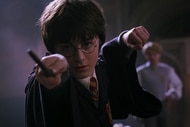Create a free profile to get unlimited access to exclusive videos, sweepstakes, and more!
Animorphs: The Graphic Novel is a 'visceral' adaptation, creator Chris Grine says
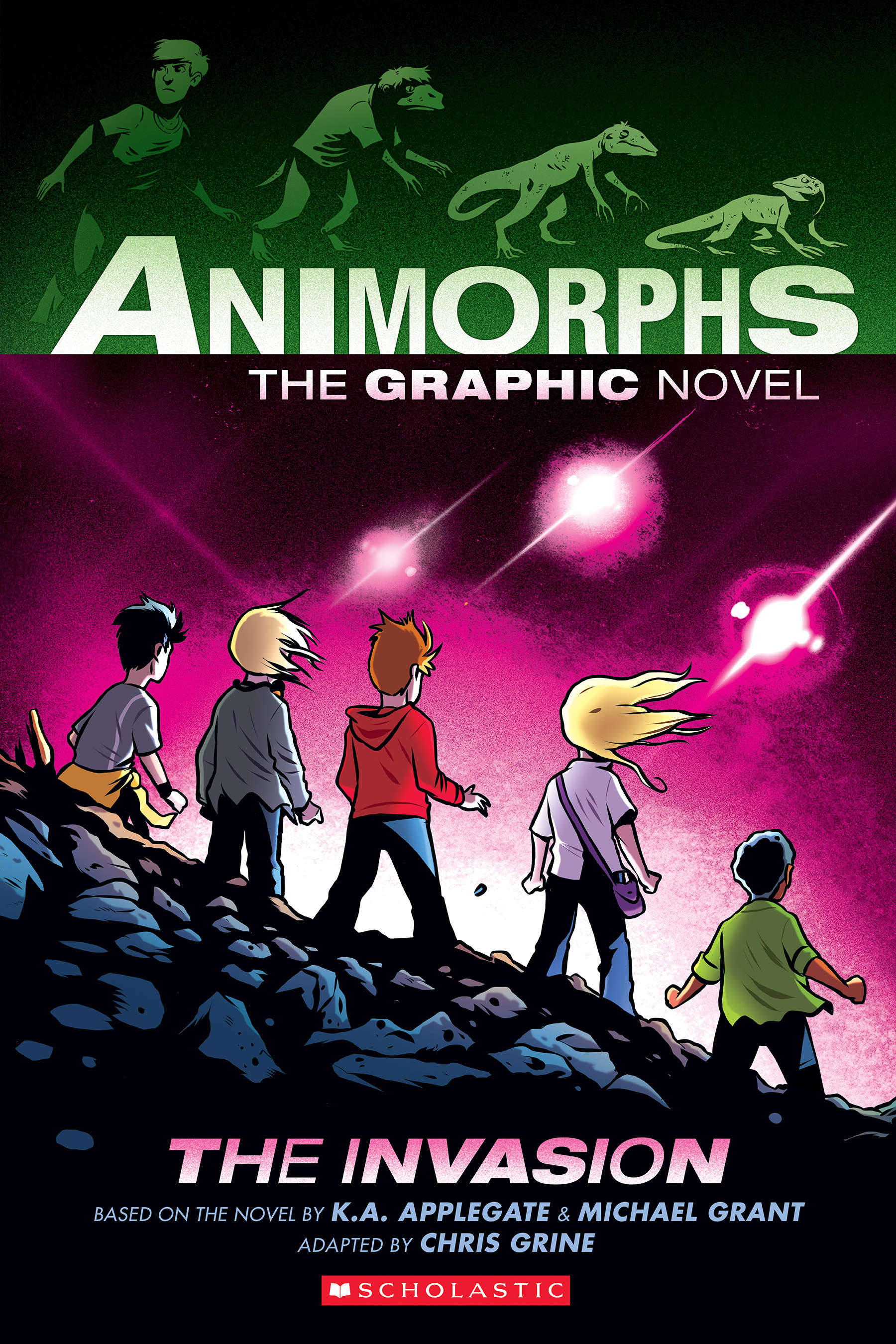
It’s been 24 years since Animorphs first kicked off the saga of five teenagers gifted with the alien power to “morph” (aka transform) into any animal they wish in order to fight back against a secret alien invasion. But since the first book was published, fans have only grown more devoted to the beloved series by authors K.A. Applegate and Michael Grant.
So when Eisner Award-nominated cartoonist Chris Grine (Time Shifters) was tasked with adapting the first installment in the 54-book series — fittingly titled The Invasion — into a graphic novel for Scholastic Graphix, he knew he had to get it right.
“I’m not a fan of poorly adapted stuff. Especially when you’re such a big fan of the source material,” Grine tells SYFY WIRE. “You really don’t want to see it get changed for reasons that just don’t make sense ... So I wanted to keep it true to what the fans remember and love.”
One of the things that has really resonated with readers since the series first debuted was its very real treatment of what teenagers Jake, Rachel, Cassie, Marco, and Tobias were going through as they fought back against the Yeerks, an evil slug-like species of alien that took control of human hosts (aka "controllers") while also balancing homework, family, and friendship. Grine knew right away that he'd have to nail that aspect, as it's what's stuck with fans even all these years later.
"Animorphs was written in a way that respected the fact that kids are more than capable of handling some larger issues, whether that's relationship-wise or dealing with the potential alien invasion," he says of the series' approach to its central themes, which don't shy away from the potential horrors of war and its prolonged effect on those fighting in one, while still acknowledging the more normal, mundane facets of being a teen. "I really liked how it would be fun for a while and they'd be having their kid conversations and doing kids' [stuff], but then the stakes would get turned up really high and they'd have to make more adult decisions. I can totally see why kids of that generation who were reading them as they came out were really hooked on them."
To ensure that he captured the tone of the series, right down to the point of view of a single first-person narrator that drives each book — the first is narrated by Jake, with each subsequent one narrated by a different member of the "Animorphs" in steady rotation — Grine closely followed the dialogue from the actual book, adapting it to fit his own script for the graphic novel wherever he could. He also closely studied Applegate and Grant’s writing to see if there were sections of narrated thought or action that could possibly serve as dialogue in a scene that might not have any.
“The first book is all about Jake, and since I knew this wasn’t going to be the case [with the graphic novel, and] that it was just going to be an ongoing narrative with all the kids, I was trying not to have any thought balloons as much as I could, because I felt like it would feel weird,” Grine explains. “Instead I would prompt somebody to ask something else that would then lead to that kind of answer or response [as spoken dialogue within the scene].”
Hewing close to the original books didn’t prevent Grine from having room to be creative with his visuals, and put his own slight spin on the Animorphs story as it will be encountered by new fans who may never have picked up or even heard of the series. One of the first ways in which he did this was the character designs, which were actually close to what he’d initially pitched Scholastic Graphix when he first took on the project. Grine based these on the descriptions in the book themselves, though he did take a few liberties, both to fit his own creative process and as a nod to the fandom that has formed around the books.
“Anytime you see any kind of Cassie fan art, she’s always wearing her overalls and boots. So I wanted to part from that just a little bit,” Grine says of one of his big choices in The Invasion. “Personally, I grew up in a part of the United States where a lot of my friends lived and worked on farms, and literally nobody ever came to school wearing overalls and boots.”
However, that’s not to say the now-iconic outfit won’t make an appearance in future adaptations of the following books, as Grine will also be working on the graphic novel adaptation for the next two books in the series: The Visitor and The Encounter.
“I’m definitely bringing that back in Book 2,” Grine says, noting that it’s also a way to signal some of the time progression that takes place within the series as it unfolds. “Marco’s got longer hair in the books, and I started it off just a little shorter than that and a little more spiked up. In the second book he’s combing it a little differently too, so it just gave it a little bit of character growth. It [also] gives me something to look forward to as I go, just little changes in the way I’m drawing the characters.”
Another way Grine is putting his own stamp on the story is in how he's chosen to depict some of the bigger action set pieces within the book, including some of the big battles featuring the Animorphs and some of the other core aliens at the center of the series: the Andalites who gifted the teens with their powers, the innocent-but-Yeerk-controlled Hork Bajir and larger, more vicious (and also Yeerk-controlled) Taxons, who tend to serve Yeerk overlords. The result is a set of sequences that are a little more hard-hitting than they were in the original book, while still maintaining the spirit of Applegate and Grant's vision.
"It makes it a more visceral reading of it," Grine says of his translation choices. "Like with Rachel turning into an elephant and stomping on the Taxons. In the book, it's described [that] she stomps on them and they rip open and it's not a throwaway line, but they move on to the next thing very quickly."
He continues, "So when I had the opportunity to actually draw that because that's what [was] happening, I think it's different from reading it to actually seeing it depicted. ... I was surprised they let me get as graphic as I did, but I think it needed it."
And of course, it wouldn't be Animorphs without the morphing itself, which Grine manages to capture in a way that harkens back to the now-iconic original covers of the series, which saw various models transform into an animal in a series of stages. Though for the purpose of time and space within the pages of the graphic novel, the whole thing is depicted more efficiently, with one major transformation being shown in detail and the rest happening off the page or more quickly.
"I was thinking of lots of quick cuts. That's why I did that one of Tobias shrinking down, because I thought that at least for the first one I wanted to make sure that people who maybe hadn't read the books or weren't quite as well versed understood that it's a change and it's in size and everything," Grine says of how he conceptualized the process. "I could have done 30 pages of them morphing every time, but I thought if I leaned in more heavy at the beginning of the book, then towards the end I'd be able to skip over just a little bit from time to time."
Since it's been two decades since the series first launched, there was some discussion about whether the graphic novels should still be set in the '90s, as they were when the books were first being published, or whether they should be moved to a more recent time, with more updated technologies. Grine says he wanted to keep it a period piece, as it was more authentic to the series itself — and didn't result in any quick fixes that might mess with the overarching plot of the saga.
"I'm very much a child of the '90s, [so] I do recognize the fashion and the music and stuff like that, and anytime I get a chance to throw that in there, I do," Grine says. "But I think that's why shows like Stranger Things are so successful. It is set in the '80s, which makes it pretty cool already, but from a storytelling perspective, if those kids have cell phones, it'd be over. It just wouldn't be much. And the same thing with Animorphs. If they'd had cell phones they could call home. It would have created more problems than it solved."
More than aware of Animorphs' fans' passion for the series, Grine hopes not only that the graphic novel will be well received by original fans, but that it might also bring in newer readers who might turn to the original books after they've finished the graphic novel adaptation of The Invasion.
"I hope that if they really like this book, [that] they go back and read the original prose books," he concludes. "They're going to have a slightly different experience with that too, because it's a little different. So maybe that saves something for later too."
The Invasion (Animorphs Graphix) is now available in bookstores.


